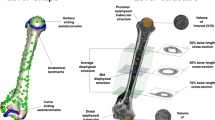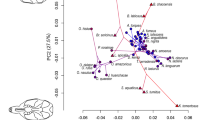Abstract
Much recent research has attempted to document and clarify the process of convergent evolution at various levels of biological organization. Studies have ranged from detailed examples of convergence at the species level (for example, Pianka and Pianka, 1970), through examples of similar evolutionary pathways having been taken by extensive subsets of communities developing within similar macrohabitats (for example, Mares, 1976, 1980, 1983), to an assessment of generally similar patterns of development of entire disjunct ecosystems sharing numerous abiotic parameters (for example, Orians and Solbrig, 1977). There has been some controversy regarding the level of ecological similarity that has developed within unrelated faunas (for example, Schall and Pianka, 1978), and whether or not convergence actually occurs among a broad array of species evolving within apparently similar micro- and macro-habitats in response to what would presumably be broadly similar selective regimes.
Access this chapter
Tax calculation will be finalised at checkout
Purchases are for personal use only
Preview
Unable to display preview. Download preview PDF.
Similar content being viewed by others
References
Andersen, D. C., Armitage, K. B., and Hoffman, R. S., 1976, Socioecology of marmots: Female reproductive strategies, Ecology 57:552–560.
Bailey, V., 1905, Biological survey of Texas, N. Am. Fauna 25:1–222.
Bailey, V., 1971, Mammals of the Southwestern United States (with Special Reference to New Mexico), Dover, New York [reprint of 1931 ed.].
Barash, D. P., 1973a, The social biology of the Olympic marmot (Marmota olympus), Anim. Behav. Monogr. 6:172–245.
Barash, D. P., 1973b, Social variety in the yellow-bellied marmot (Marmota flaviventris), Anim. Behav. 21:579–584.
Barash, D. P., 1974a, The social behavior of the hoary marmot (Marmota caligata), Anim. Behav. 22:256–261.
Barash, D. P., 1974b, The evolution of marmot societies: A general theory, Science 185:415–420.
Bronson, F. H., 1964, Agonistic behavior in woodchucks, Anim. Behav. 12:470–478.
Brown, J. H., Lieberman, G. A., and Dengler, W. F., 1972, Woodrats and cholla: Dependence of small mammal populations on the density of cacti, Ecology 53:310–313.
Burt, W. H., and Grossenheider, R. P., 1976, A Field Guide to the Mammals, Houghton Mifflin, Boston.
Cabrera, A., and Yepes, J., 1960, Mamiferos Sud Americanos, Ediar, Buenos Aires.
Coe, M. J., 1962, Notes on the habits of the Mount Kenya hyrax (Procavia johnstoni mackinderi: Thomas), Proc. Zool. Soc. Lond. 138:639–644.
Corbet, G. B., and Hill, J. E., 1980, A World List of Mammalian Species, Comstock, London.
Cowan, I. M., and Guiguet, C. J., 1978, The Mammals of British Columbia, British Columbia Provincial Museum, Victoria.
Downhower, J. F., and Armitage, K. B., 1971, The yellow-bellied marmot and the evolution of polygamy, Am. Nat. 105:355–370.
Dubost, G., and Genest, H., 1974, Le comportement social d’une colonie de Maras Dolichotis patagonum L. dans le Parc de Branfère, Z. Tierpsychol. 35:225–302.
Eisenberg, J. F., 1974, The function and motivational basis of hystricomorph vocalizations, in: The Biology of Hystricomorph Rodents (I. W. Rowlands and B. J. Weir, eds.), Academic Press, London, pp. 211–244.
Eisenberg, J. F., 1981, The Mammalian Radiations, University of Chicago Press, Chicago.
Emlen, S. T., and Oring, L. W., 1977, Ecology, sexual selection, and the evolution of mating systems, Science 197:215–223.
Escherich, P. C, 1981, Social biology of the bushy-tailed woodrat, Neotoma cinerea, Univ. Calif. Puhl. Zool. 100:1–132.
Fischer, G. M., 1978, Los Pequenos Mamiferos de Chile, Gayana, Concepciön.
Frase, B. A., and Hoffmann, R. S., 1980, Marmota flaviventris, Mammal. Species 135:1–8.
Fricke, H. W., 1980, Control of different mating systems in coral reef fish by one environmental factor, Anim. Behav. 28:561–569.
George, W., 1974, Notes on the ecology of gundis (F. Ctenodactylidae), in: The Biology of Hystricomorph Rodents (I. W. Rowlands and B. J. Weir, eds.), Academic Press, London, pp. 143–160.
Hoeck, H., 1975, Differential feeding behavior of the sympatric hyrax Procavia johnstoni and Heterohyrox brucei, Oecologia 22:15–47.
Hoeck, H., 1982, Population dynamics, dispersal, and genetic isolation in two species of hyrax (Heterohyrax brucei and Procavia johnstoni) on habitat islands in the Serengeti, Z. Tierpsychol. 59:177–210.
Hoeck, H. N., Klein, H., and Hoeck, P., 1982, Flexible social organization in hyrax, Z. Tierpsychol. 59:265–298.
Hoffmeister, D. F., 1967, Tubulidentates, proboscideans, and hyracoideans, in: Recent Mammals of the World (S. Anderson and J. K. Jones, Jr., eds.), Ronald Press, New York, pp. 355–365.
Honacki, J. H., Kinman, K. E., and Koepple, J. W., 1982, Mammal Species of the World: A Taxonomic and Geographic Reference, Allen Press, Lawrence.
Howe, R. J., 1978, Agonistic behavior of three sympatric species of woodrats (Neotoma mexicana, N. albigula, and N. stephensi), J. Mammal. 59:780–786.
Jones, C., 1978, Dendrohyrax dorsalis, Mammal. Species 113:1–4.
Kawamichi, T., 1970, Social pattern of the Japanese pika, Ochotona hyperborea yesoensis, preliminary report, J. Fac. Sci. Hokkaido Univ. Ser. VI Zool. 17:462–473.
Kawamichi, T., 1971, Daily activities and social pattern of two Himalayan pikas, Ochotona macrotis and O. roylei, observed at Mt. Everest, J. Fac. Sci. Hokkaido Univ. Ser. VI Zool. 17:587–609.
Kawamichi, T., 1976, Hay territory and dominance rank of pikas (Ochotona princeps), J. Mammal. 57:133–148.
Kingdon, J., 1971, East African mammals, I, Academic Press, London.
Kingdon, J., 1974, East African mammals, IIB, Academic Press, London.
Kock, D., and Schomber, H. W., 1960, Our days among the gundis (Ctenodactylus gundi), Afr. Wild Life 14:199–203.
Lacher, T. E., Jr., 1979, Rates of growth in Kerodon rupestris and an assessment of its potential as a domesticated food source, Pap. Avulsos Zool. (São Paulo) 33:67–76.
Lacher, T. E., Jr., 1980, The comparative social behavior of Kerodon rupestris and Galea spixii in the xeric caatinga of northeastern Brazil, Ph. D. thesis, University of Pittsburgh.
Lacher, T. E., Jr., 1981, The comparative social behavior of Kerodon rupestris and Galea spixii and the evolution of behavior in the caviidae, Bull. Carnegie Mus. Nat. Hist. 17:1–71.
Lacher, T. E., Jr., 1981, The comparative social behavior of Kerodon rupestris and Galea spixii and the evolution of behavior in the Caviidae, Bull. Carnegie Mus. Nat. Hist. 17:1–71.
Lee, D. S., and Funderburg, J. B., 1982, Marmots, in: Mammals of North America (J. A. Chapman and G. A. Feldhamer, eds.), Johns Hopkins University Press, Baltimore, pp. 176–191.
MacArthur, R., 1972, Geographical Ecology, Harper and Row, New York.
Mares, M. A., 1976, Convergent evolution of desert rodents: Multivariate analysis and Zoogeographie implications, Paleobiology 2:39–63.
Mares, M. A., 1980, Convergent evolution among desert rodents: A global perspective, Bull. Carnegie Mus. Nat. Hist. 16:1–51.
Mares, M. A., 1983, Desert rodent adaptation and community structure, Great Basin Nat. Mem. 7:30–43.
Mares, M. A., Willig, M. R., Streilein, K. E., and Lacher, T. E., Jr., 1981a, The mammals of northeastern Brazil: A preliminary assessment, Ann. Carnegie Mus. 50:80–137.
Mares, M. A., Ojeda, R., and Kosco, M., 1981b, Observations on the distribution and ecology of the mammals of Salta Province, Argentina, Ann. Carnegie Mus. 50:151–206.
Markham, C. G., 1972, Aspectos Climatologicos da Seca no Brasil-Nordeste, Sudene Assessouria Técnica, Divisão de Documentacão, Recife.
Morrison, D. W., 1979, Apparent male defense of tree hollows in the fruit bat, Artibeus jamaicensis, J. Mammal. 60:11–15.
Nowak, R. M., and Paradiso, J. L., 1983, Walker’s Mammals of the World, Johns Hopkins University Press, Baltimore.
Orians, G. H., and Solbrig, O. T., 1977, Convergent Evolution in Warm Deserts, Dowden, Hutchison, and Ross, Stroudsburg.
Osgood, W. H., 1943, The mammals of Chile, Zool. Ser. Field Mus. Nat. Hist. 30:1–268.
Pearson, O. P., 1948, Life history of mountain viscachas in Peru, J. Mammal. 29:345–373.
Pianka, E. R., and Pianka, H. D., 1970, The ecology of Moloch horridus (Lacertilia: Agamidae) in Western Australia, Copeia 1970:90–103.
Richardson, W. B., 1943, Woodrats (Neotoma albiguia): Their growth and development, J. Mammal. 24:130–143.
Ride, W. D. L., 1970, A Guide to the Native Mammals of Australia, Oxford University Press, Melbourne.
Rood, J. P., 1970, Ecology and social behavior of the desert cavy (Microcavia australis), Am. Midi. Nat. 83:415–454.
Rood, J. P., 1972, Ecological and behavioral comparisons of three genera of Argentine cavies, Anim. Behav. Monogr. 5:1–83.
Rosevear, D. R., 1969, The Rodents of West Africa, British Museum (Natural History), London.
Schall, J. J., and Pianka, E. R., 1978, Geographical trends in numbers of species, Science 201:679–686.
Sharp, P. L., 1973, Behavior of the pika, (Ochotona princeps), in the Kananaskis region of Alberta, M. Sc. thesis, University of Alberta, Edmonton.
Smith, A. T., 1974a, The distribution and dispersal of pikas: Consequences of insular population structure, Ecology 55:1112–1119.
Smith, A. T., 1974b, The distribution and dispersal of pikas: Influences of behavior and climate, Ecology 55:1368–1376.
Smith, A. T., 1978, Comparative demography of pikas (Ochotona): Effect of spatial and temporal age-specific mortality, Ecology 59:133–139.
Smith, A. T., 1979, Equilibrial population structure of pikas, Murrelet 60:30–31.
Smith, A. T., 1980, Temporal changes in insular populations of the pika (Ochotona princeps), Ecology 61:8–13.
Smith, A. T., 1981a, Population dynamics of pikas (genus Ochotona), in: Proceedings of the World Lagomorph Conference (K. Myers and C. D. Maclnnes, eds.), Guelph University Press, Guelph, Ontario, pp. 572–586.
Smith, A. T., 1981b, Territoriality and social behavior of Ochotona princeps, in: Proceedings of the World Lagomorph Conference (K. Myers and C. D. Maclnnes, eds.), Guelph University Press, Guelph, Ontario, pp. 310–323.
Smith, A. T., and Ivins, B., 1984, Spatial relationships and social organization in adult pikas: A facultatively monogamous mammal, Z. Tierpsychol. 66:289–308.
Sneath, P. H. A., and Sokal, R. R., 1973, Numerical Taxonomy, Freeman, San Francisco.
Stacey, P. B., and Bock, C. E., 1978, Social plasticity in the acorn woodpecker, Science 202:1298–1300.
Streilein, K. E., 1982a, Ecology of small mammals in the semiarid Brazilian Caatinga. I. Climate and faunal composition, Ann. Carnegie Mus. 51:79–107.
Streilein, K. E., 1982b, The ecology of small mammals in the semiarid Brazilian Caatinga. IV. Habitat selection, Ann. Carnegie Mus. 51:331–343.
Svendsen, G. E., 1979, Territoriality and behavior in a population of pikas (Ochotona princeps), J. Mammal. 60:324–330.
Tapper, S. C., 1973, The spatial organization of pikas (Ochotona), and its effect on population recruitment, Ph. D. thesis, University of Alberta, Edmonton.
Troughton, E., 1943, Furred Mammals of Australia, Angus and Robertson, Sydney.
Tyndale-Biscoe, H., 1973, Life of Marsupials, Elsevier, New York.
Vanzolini, P. E., Ramos-Costa, A. M. M., and Vitt, L. J., 1980, Repteis das Caatingas, Academia Brasileira de Ciencias, Rio de Janeiro.
Vitt, L. J., 1981, Lizard reproduction: Habitat specificity and constraints on relative clutch mass, Am. Nat 117:506–514.
Walker, E., 1975, Mammals of the World, Johns Hopkins University Press, Baltimore.
Weatherhead, P. J., 1979, Ecological correlates of monogamy in tundra-breeding savannah sparrows, Auk 96:391–401.
Willig, M. R., 1982, A comparative ecological study of Caatingas and Cerrado Chiropteran communities: Composition, structure, morphometrics and reproduction, Ph. D. thesis, University of Pittsburgh.
Willig, M. R., 1983, Composition, microgeographic variation, and sexual dimorphism in Caatingas and Cerrado bat communities from Northeast Brazil, Bull. Carnegie Mus. Nat. Hist. 23:1–131.
Wilson, E. O., 1975, Sociohiology, Harvard University Press, Cambridge, Massachusetts.
Wilson, S. C., and Kleiman, D. C., 1974, Eliciting play: A comparative study, Am. Zool. 14:341–370.
Wittenberger, J. F., 1979, The evolution of mating systems in birds and mammals, in: Handbook of Behavioral Neurobiology, Volume 3 (P. Marier and J. Vandenbergh, eds.), Plenum Press, New York. pp. 271–349.
Author information
Authors and Affiliations
Editor information
Editors and Affiliations
Rights and permissions
Copyright information
© 1987 Springer Science+Business Media New York
About this chapter
Cite this chapter
Mares, M.A., Lacher, T.E. (1987). Ecological, Morphological, and Behavioral Convergence in Rock-Dwelling Mammals. In: Genoways, H.H. (eds) Current Mammalogy. Springer, Boston, MA. https://doi.org/10.1007/978-1-4757-9909-5_8
Download citation
DOI: https://doi.org/10.1007/978-1-4757-9909-5_8
Publisher Name: Springer, Boston, MA
Print ISBN: 978-1-4757-9911-8
Online ISBN: 978-1-4757-9909-5
eBook Packages: Springer Book Archive




